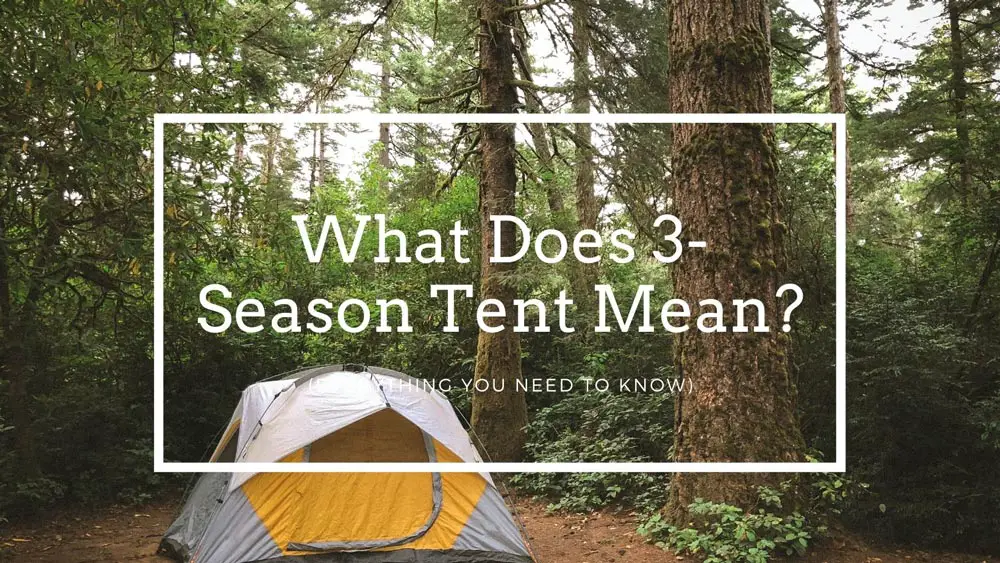Being out in the wilderness can be one of life’s most liberating experiences. Therefore, choosing the proper backcountry shelter is one of the crucial considerations when planning your next outdoor adventure. Spacious and feature-rich camping tents are the perfect way to get the most out of your wilderness experience.
The camping tent you choose can significantly affect your budget and pack weight, so it is one of the most important gear-buying decisions. Camping tents are often rated by season, and your main choice is between a 3-season and a 4-season tent. But questions remain. What does 3-season tent mean? What is the difference between 3 and 4 season tents? Can a three-season tent be used in the winter?
Hopefully, after reading this post, you will have the confidence to decide which one is right for you based on your needs. And if you still have any questions unanswered, comment below.
What Does 3-Season Tent Mean?
A 3 season tent, as its name suggests, is designed for spring, summer, and fall. It’s generally referred to as a backpacking tent because it’s often made of lighter fabrics and features more mesh, and build them in such a way as to minimize the total amount needed and provide as much ventilation as possible. The main objective of a 3 season tent is to protect you from insects and light wind and rain. However, a three-season tent won’t shield you from extreme weather, holding up to fierce winds(gusts of 30+ mph) and heavy snow loads.
Do I Need a 3-Season Tent?
It depends on how often you’ll be winter camping in alpine settings. A 3-season tent is suitable for trekking through winding trails in spring, backpacking to the top of mountains during summer, and camping under the stars in fall. You don’t have to make a two-time investment if you’re not the type of person who loves camping in the winter. Renting a 4-season tent when needed is much easier on your wallet and just as convenient.
In terms of my experience being an adventure freak, 3-Season tents are:
Lightweight and Durable
As I said before, 3-season tents tend to save a bit of weight by using very light materials. Most 3 season tents feature tent poles made with aluminum or carbon fiber, which are strong enough to withstand cold weather and handle snow loads, so you don’t have to worry about being stranded inside of a broken-down shelter during inclement weather.
Some of the newest innovations in tent design allow trekking poles and other items that many hikers already carry, such as carabiners or even a dog leash, to serve as lightweight structural support instead of traditional metal poles structures, which can add significant weight.
Many standard designs have clips on each side at about head height (to attach it quickly). And others utilize trekking poles themselves to create an “A-frame” structure without any need for additional equipment like stakes or aluminum rods/poles are usually being used when needed if something is blocking the ground below from supporting your shelter fully.
Pro tip: Beware of fiberglass tent poles. They shatter in cold temperatures when stressed by the weight of a heavy load.
Excellent Ventilation
3-season tents feature lots of open mesh panels and windows that provide you with excellent ventilation during these seasons of weather, which means they’ll be your best bet to handle a variety of conditions. Usually, 3-season tent vestibules sit slightly up from the ground so air can circulate in more efficiently as well!
Greater Versatility
A 3-season tent is notable for its versatility because it typically contains a separate rainfly and inner tent (a double-wall construction). You can take the rainfly off to have a clear view of your surroundings or put it back on for protection from rain and wind. If you are sure that it won’t rain on your trip, then there is no need to pack the rainfly at all in shoulder season.
Ease of Setup
Tents have come a long way since they were first designed, thanks to the new technology and advanced materials. Gone are the days of setting up an enormous tent and threading poles through sleeves to keep it standing upright!
Today’s tents rely on clips, especially these 3-season tents, which connect easily to both walls and tent poles for quick setup time that is also user-friendly. And if you backpack with trekking poles, then this option gives you a chance to save your back by not having to lug around heavy pole sets in addition.
Can I use a 3 season tent in winter?
Yes, you can use a three-season tent for winter camping or backpacking if you set it up below the treeline. You can find many styles of 3-season tents perfect for cold weather, such as aluminum and carbon fiber poles and plenty of sleeping insulation to keep you warm in frigid temperatures.
When winter sets in, a three-season tent can be made more comfortable with just one simple trick. Build windbreaks, dig a snow cave or other snow shelter, or enhance vestibule areas out of snow to help you stay warm and dry while camping during the cold season!
If your 3-season tent has guy lines or places to attach them, tie them off to a stake or tree, which will significantly boost its strength and stability. They work best if they’re supporting the poles, not just the fabric of the tent.
Three-season tents also usually have roomy vestibules where you’ll store your gear, so it’s out of the snow!
Pro tip: The site selection is the key because you should be more worried about wind than snow. Make sure you get out of the wind and pitch the narrow side of the tent facing directly into the wind direction, not the broadside.
The Bottom Line
Now you know all there is to know about what does a 3-season tent means. A 3 season tent is the perfect option for campers who do not plan to sleep in extreme weather conditions. They’re lighter and cheaper than four-season tents, easier to set up for most people who don’t have any experience with them before, and provide enough protection from all but the harshest weather.


